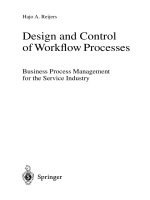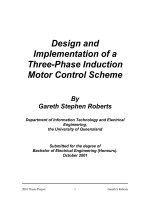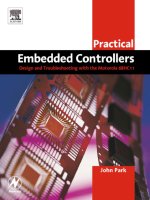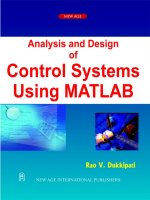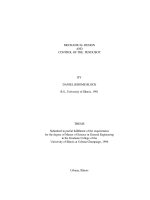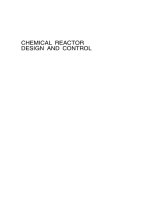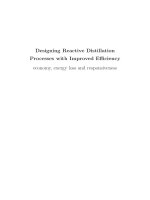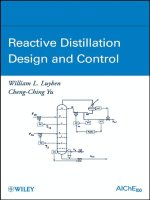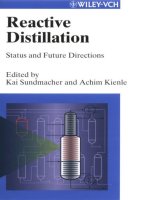reactive distillation design and control
Bạn đang xem bản rút gọn của tài liệu. Xem và tải ngay bản đầy đủ của tài liệu tại đây (15.72 MB, 599 trang )
REACTIVE DISTILLATION
DESIGN AND CONTROL
WILLIAM L. LUYBEN
Lehigh University
CHENG-CHING YU
National Taiwan University
REACTIVE DISTILLATION
DESIGN AND CONTROL
REACTIVE DISTILLATION
DESIGN AND CONTROL
WILLIAM L. LUYBEN
Lehigh University
CHENG-CHING YU
National Taiwan University
Copyright # 2008 by John Wiley & Sons, Inc. All rights reserved
Published by John Wiley & Sons, Inc., Hoboken, New Jersey
Published simultaneously in Canada
No part of this publication may be reproduced, stored in a retrieval system, or transmitted in any form or by any
means, electronic, mechanical, photocopying, recording, scanning, or otherwise, except as permitted under Section
107 or 108 of the 1976 United States Copyright Act, without either the prior written permission of the Publisher, or
authorization through payment of the appropriate per-copy fee to the Copyright Clearance Center, Inc., 222
Rosewood Drive, Danvers, MA 01923, (978) 750-8400, fax (978) 750-4470, or on the web at www.copyright.
com. Requests to the Publisher for permission should be addressed to the Permissions Department, John Wiley
& Sons, Inc., 111 River Street, Hoboken, NJ 07030, (201) 748-6011, fax (201) 748-6008, or online at http://
www.wiley.com/go/permission.
Limit of Liability/Disclaimer of Warranty: While the publisher and author have used their best efforts in preparing
this book, they make no representations or warranties with respect to the accuracy or completeness of the contents
of this book and specifically disclaim any implied warranties of merchantability or fitness for a particular purpose.
No warranty may be created or extended by sales representatives or written sales materials. The advice and strat-
egies contained herein may not be suitable for your situation. You should consult with a professional where appro-
priate. Neither the publisher nor author shall be liable for any loss of profit or any other commercial damages,
including but not limited to special, incidental, consequential, or other damages.
For general information on our other products and services or for technical support, please contact our Customer
Care Department within the United States at (800) 762-2974, outside the United States at (317) 572-3993 or fax
(317) 572-4002.
Wiley also publishes it books in variety of electronic formats. Some content that appears in print may not be
available in electronic formats. For more information about Wiley products, visit our web site at www.wiley.com.
Library of Congress Cataloging-in-Publication Data:
Luyben, William L.
Reactive distillation design and control/William L. Luyben, Cheng-Ching Yu.
p. cm.
Includes index.
ISBN 978-0-470-22612-4 (cloth)
1. Distillation apparatus- -Design and construction. 2. Chemical process control. 3. Distillation.
4. Reactivity (Chemistry) I. Yu, Cheng-Ching, 1956– II. Title.
TP159.D5L895 2008
660
0
.28425 dc22 2008007189
Printed in the United States of America
10987654321
This book is dedicated to Albert, Jessica and Patricia (CCY) and to all
my former graduate students who have carried on the Lehigh tradition
of engineering excellence (WLL).
CONTENTS
PREFACE xvii
1 INTRODUCTION 1
1.1 History 2
1.2 Basics of Reactive Distillation 3
1.3 Neat Operation Versus Excess Reactant 7
1.4 Limitations 8
1.4.1 Temperature Mismatch 8
1.4.2 Unfavorable Volatilities 9
1.4.3 Slow Reaction Rates 9
1.4.4 Other Restrictions 9
1.5 Scope 9
1.6 Computational Methods 10
1.6.1 Matlab Programs for Steady-State Design 10
1.6.2 Aspen Simulations 10
1.7 Reference Materials 11
vii
PART I STEADY-STATE DESIGN OF IDEAL
QUATERNARY SYSTEM 15
2 PARAMETER EFFECTS 17
2.1 Effect of Holdup on Reactive Trays 20
2.2 Effect of Number of Reactive Trays 22
2.3 Effect of Pressure 24
2.4 Effect of Chemical Equilibrium Constant 27
2.5 Effect of Relative Volatilities 29
2.5.1 Constant Relative Volatilities 30
2.5.2 Temperature-Dependent Relative Volatilities 30
2.6 Effect of Number of Stripping and Rectifying Trays 32
2.7 Effect of Reactant Feed Location 33
2.7.1 Reactant A Feed Location (N
FA
)33
2.7.2 Reactant B Feed Location (N
FB
)35
2.8 Conclusion 36
3 ECONOMIC COMPARISON OF REACTIVE DISTILLATION
WITH A CONVENTIONAL PROCESS 37
3.1 Conventional Multiunit Process 38
3.1.1 Assumptions and Specifications 38
3.1.2 Steady-State Design Procedure 40
3.1.3 Sizing and Economic Equations 42
3.2 Reactive Distillation Design 43
3.2.1 Assumptions and Specifications 44
3.2.2 Steady-State Design Procedure 45
3.3 Results for Different Chemical Equilibrium Constants 47
3.3.1 Conventional Process 47
3.3.2 Reactive Distillation Process 54
3.3.3 Comparisons 61
3.4 Results for Temperature-Dependent Relative Volatilities 61
3.4.1 Relative Volatilities 62
3.4.2 Optimum Steady-State Designs 64
3.4.3 Real Chemical Systems 69
3.5 Conclusion 70
4 NEAT OPERATION VERSUS USING EXCESS REACTANT 71
4.1 Introduction 72
4.2 Neat Reactive Column 72
4.3 Two-Column System with Excess B 75
4.3.1 20% Excess B Case 76
4.3.2 10% Excess B Case 78
viii CONTENTS
4.4 Two-Column System with 20% Excess of A 81
4.5 Economic Comparison 85
4.6 Conclusion 86
PART II STEADY-STATE DESIGN OF OTHER
IDEAL SYSTEMS 87
5 TERNARY REACTIVE DISTILLATION SYSTEMS 89
5.1 Ternary System Without Inerts 90
5.1.1 Column Configuration 90
5.1.2 Chemistry and Phase Equilibrium Parameters 90
5.1.3 Design Parameters and Procedure 92
5.1.4 Effect of Pressure 94
5.1.5 Holdup on Reactive Trays 94
5.1.6 Number of Reactive Trays 94
5.1.7 Number of Stripping Trays 94
5.2 Ternary System With Inerts 99
5.2.1 Column Configuration 99
5.2.2 Chemistry and Phase Equilibrium Parameters 99
5.2.3 Design Parameters and Procedure 100
5.2.4 Effect of Pressure 102
5.2.5 Control Tray Composition 103
5.2.6 Reactive Tray Holdup 105
5.2.7 Effect of Reflux 107
5.2.8 Chemical Equilibrium Constant 109
5.2.9 Feed Composition 109
5.2.10 Number of Reactive Trays 113
5.2.11 Number of Rectifying and Stripping Trays 113
5.3 Conclusion 116
6 TERNARY DECOMPOSITION REACTION 119
6.1 Ternary Decomposition Reaction: Intermediate-Boiling Reactant 120
6.1.1 Column Configuration 120
6.1.2 Chemistry and Phase Equilibrium Parameters 120
6.1.3 Design Parameters and Procedure 121
6.1.4 Holdup on Reactive Trays 123
6.1.5 Number of Reactive Trays 124
6.1.6 Number of Rectifying and Stripping Trays 126
6.1.7 Location of Feed Tray 126
6.2 Ternary Decomposition Reaction: Heavy Reactant with
Two-Column Configurations 127
6.2.1 Column Configurations 127
6.2.2 Chemistry and Phase Equilibrium Parameters 128
6.2.3 Design Parameters and Procedure 128
CONTENTS ix
6.2.4 Reactive Holdup 129
6.2.5 Number of Reactive Trays 131
6.2.6 Number of Rectifying Trays 132
6.3 Ternary Decomposition Reaction: Heavy Reactant with
One-Column Configurations 134
6.3.1 Feasibility Analysis 134
6.3.2 Column Configuration 139
6.3.3 Design Parameters and Procedure 139
6.3.4 Reactive Tray Holdup 139
6.3.5 Number of Reactive Trays 139
6.3.6 Number of Rectifying Trays 140
6.3.7 Location of Feed Tray 143
6.3.8 Comparison Between These Two Flowsheets 143
6.4 Conclusion 143
PART III STEADY-STATE DESIGN OF REAL
CHEMICAL SYSTEMS 145
7 STEADY-STATE DESIGN FOR ACETIC ACID
ESTERIFICATION 147
7.1 Reaction Kinetics and Phase Equilibria 147
7.1.1 Reaction Kinetics 147
7.1.2 Phase Equilibria 149
7.2 Process Flowsheets 153
7.2.1 Type I Flowsheet: MeAc 153
7.2.2 Type II Flowsheet: EtAc and IPAc 156
7.2.3 Type III Flowsheet: BuAc and AmAc 157
7.3 Steady-State Design 158
7.3.1 Design Procedure 158
7.3.2 Optimized Design 160
7.4 Process Characteristics 168
7.4.1 Type I: MeAc 168
7.4.2 Type II: EtAc and IPAc 168
7.4.3 Type III: BuAc and AmAc 170
7.5 Discussion 175
7.6 Conclusion 177
8 DESIGN OF TAME REACTIVE DISTILLATION SYSTEMS 179
8.1 Chemical Kinetics and Phase Equilibrium 180
8.1.1 Chemical Kinetics 180
8.1.2 Phase Equilibrium Using Aspen Plus 181
8.1.3 Conceptual Design 186
x CONTENTS
8.2 Component Balances 194
8.3 Prereactor and Reactive Column 195
8.3.1 Base Case Design of Reactive Column 195
8.3.2 Effect of Design Parameters on Reactive Column 199
8.4 Pressure-Swing Methanol Separation Section 208
8.5 Extractive Distillation Methanol Separation Section 209
8.6 Economic Comparison 210
8.7 Conclusion 212
9 DESIGN OF MTBE AND ETBE REACTIVE
DISTILLATION COLUMNS 213
9.1 MTBE Process 213
9.1.1 Phase Equilibrium 214
9.1.2 Reaction Kinetics 214
9.1.3 Aspen Plus Simulation Issues 214
9.1.4 Setting up the Aspen Plus Simulation 215
9.1.5 Effect of Design Parameters 221
9.1.6 Chemical Equilibrium Model 229
9.2 ETBE Process 231
9.2.1 Kinetic Model 231
9.2.2 Process Studied 232
9.2.3 User Subroutine for ETBE 232
9.2.4 Chemical Equilibrium Model 234
9.2.5 Effects of Design Parameters 236
9.3 Conclusion 237
PART IV CONTROL OF IDEAL SYSTEMS 239
10 CONTROL OF QUATERNARY REACTIVE
DISTILLATION COLUMNS 241
10.1 Introduction 242
10.2 Steady-State Design 243
10.3 Control Structures 245
10.4 Selection of Control Tray Location 246
10.5 Closed-Loop Performance 247
10.5.1 CS7-R Structure 247
10.5.2 CS7-RR Structure 248
10.6 Using More Reactive Trays 249
10.6.1 Steady-State Design 249
10.6.2 SVD Analysis 250
10.6.3 Dynamic Performance of CS7-RR 253
CONTENTS xi
10.7 Increasing Holdup on Reactive Trays 254
10.8 Rangeability 256
10.9 Conclusion 259
11 CONTROL OF EXCESS REACTANT SYSTEMS 261
11.1 Control Degrees of Freedom 261
11.2 Single Reactive Column Control Structures 263
11.2.1 Two-Temperature Control Structure 265
11.2.2 Internal Composition Control Structure 272
11.3 Control of Two-Column System 278
11.3.1 Two-Temperature Control 279
11.3.2 Temperature/Composition Cascade Control 285
11.4 Conclusion 292
12 CONTROL OF TERNARY REACTIVE
DISTILLATION COLUMNS 293
12.1 Ternary System Without Inerts 293
12.1.1 Column Configuration 293
12.1.2 Control Structure CS1 296
12.1.3 Control Structure CS2 300
12.1.4 Control Structure CS3 303
12.2 Ternary System With Inerts 310
12.2.1 Column Configuration 310
12.2.2 Control Structure CS1 310
12.2.3 Control Structure CS2 314
12.2.4 Control Structure CS3 320
12.2.5 Conclusion for Ternary A þ B , C System 322
12.3 Ternary A , B þ C System: Intermediate-Boiling Reactant 324
12.3.1 Column Configuration 324
12.3.2 Control Structure CS1 326
12.3.3 Control Structure CS2 329
12.3.4 Control Structure CS3 334
12.4 Ternary A , B þ C System: Heavy Reactant
With Two-Column Configuration 334
12.4.1 Column Configuration 334
12.4.2 Control Structure CS1 334
12.4.3 Control Structure CS2 335
12.5 Ternary A , B þ C System: Heavy Reactant
With One-Column Configuration 342
12.5.1 Column Configuration 342
12.5.2 Control Structure CS1 342
12.5.3 Control Structure CS2 344
12.5.4 Control Structure CS3 345
12.5.5 Conclusion for Ternary A , B þ C System 352
xii CONTENTS
PART V CONTROL OF REAL SYSTEMS 353
13 CONTROL OF REACTIVE DISTILLATIO NS FOR
ACETIC ACID ESTERIFICATION 355
13.1 Process Characteristics 355
13.1.1 Process Studies 355
13.1.2 Quantitative Analysis 356
13.2 Control Structure Design 362
13.2.1 Selection of Temperature Control Trays 363
13.2.2 Control Structure and Controller Design 366
13.2.3 Performance 368
13.2.4 Alternative Temperature Control Structures 376
13.3 Extension to Composition Control 380
13.4 Conclusion 388
14 PLANTWIDE CONTROL OF TAME REACTIVE
DISTILLATION SYSTEM 389
14.1 Process Studied 389
14.1.1 Prereactor 390
14.1.2 Reactive Column C1 391
14.1.3 Extractive Column C2 391
14.1.4 Methanol Recovery Column C3 397
14.2 Control Structure 397
14.2.1 Prereactor 397
14.2.2 Reactive Distillation Column C1 399
14.2.3 Extractive Distillation Column C2 399
14.2.4 Methanol Recovery Column C3 401
14.3 Results 403
14.4 Conclusion 406
15 CONTROL OF MTBE AND ETBE REACTIVE
DISTILLATION COLUMNS 407
15.1 MTBE Control 407
15.1.1 Steady State 407
15.1.2 Control Structure with C4 Feedflow Controlled 408
15.1.3 Control Structure with Methanol
Feedflow Controlled 416
15.2 ETBE Control 418
15.2.1 Control Structure with Flow Control
of C4 Feed 419
15.2.2 Control Structure with Flow Control
of Ethanol Feed 424
CONTENTS xiii
PART VI HYDRID AND NONCONVENTIONAL
SYSTEMS 429
16 DESIGN AND CONTROL OF COLUMN/SIDE
REACTOR SYSTEMS 431
16.1 Introduction 431
16.2 Design for Quaternary Ideal System 433
16.2.1 Assumptions and Specifications 434
16.2.2 Reactor and Column Equations 435
16.2.3 Design Optimization Procedure 436
16.2.4 Results and Discussion 437
16.2.5 Reactive Column with Optimum Feed Tray Locations 445
16.3 Control of Quaternary Ideal System 446
16.3.1 Dynamic Tubular Reactor Model 446
16.3.2 Control Structures 447
16.4 Design of Column/Side Reactor Process for Ethyl
Acetate System 458
16.4.1 Process Description 458
16.4.2 Conceptual Design 459
16.5 Control of Column/Side Reactor Process for Ethyl
Acetate System 474
16.5.1 Determining Manipulated Variables 475
16.5.2 Selection of Temperature Control Trays 479
16.5.3 Controller Design 481
16.5.4 Performance 481
16.5.5 Extension to Composition Control 485
16.5.6 Comparison with Reactive Distillation
Temperature Control 485
16.6 Conclusion 485
17 EFFECTS OF BOILING POINT RANKINGS ON THE
DESIGN OF REACTIVE DISTILLATION 487
17.1 Process and Classification 487
17.1.1 Process 487
17.1.2 Classification 490
17.2 Relaxation and Convergence 492
17.3 Process Configurations 495
17.3.1 Type I: One Group 496
17.3.2 Type II: Two Groups 501
17.3.3 Type III: Alternating 507
17.4 Results and Discussion 511
17.4.1 Summary 511
17.4.2 Excess Reactant Design 514
17.5 Conclusion 518
xiv CONTENTS
18 EFFECTS OF FEED TRAY LOCATIONS ON DESIGN AND
CONTROL OF REACTIVE DISTILLATION 519
18.1 Process Characteristics 519
18.1.1 Modeling 521
18.1.2 Steady-State Design 522
18.1.3 Base Case 522
18.1.4 Feed Locations Versus Reactants Distribution 523
18.1.5 Optimal Feed Locations 527
18.2 Effects of Relative Volatilities 529
18.2.1 Changing Relative Volatilities of Reactants 529
18.2.2 Changing Relative Volatilities of Products 530
18.2.3 Summary 532
18.3 Effects of Reaction Kinetics 533
18.3.1 Reducing Activation Energies 533
18.3.2 Effects of Preexponential Factor 536
18.4 Operation and Control 538
18.4.1 Optimal Feed Location for Production Rate Variation 538
18.4.2 Control Structure 539
18.4.3 Closed-Loop Performance 541
18.5 Conclusion 544
APPENDIX CATALOG OF TYPES OF REAL REACTIVE
DISTILLATION SYSTEMS 545
REFERENCES 563
INDEX 573
CONTENTS xv
PREFACE
Most chemical processes involve two important operations (reaction and separation) that
are typically carried out in different sections of the plant and use different equipment.
The reaction section of the process can use several types of reactors [continuous stirred-
tank reactor (CSTR), tubular, or batch] and operate under a wide variety of conditions
(catalyzed, adiabatic, cooled or heated, single phase, multiple phases, etc.). The separation
section can have several types of operations (distillation, extraction, crystallization, adsorp-
tion, etc.), with distillation being by far the most commonly used method. Recycle streams
between the two sections of these conventional multiunit flowsheets are often incorporated
in the process for a variety of reasons: to improve conversion and yield, to minimize the
production of undesirable byproducts, to improve energy efficiency, and to improve
dynamic controllability.
Instead of conducting the reaction and separation in separate units and vessels, it is
sometime possible to combine these operations in a single vessel. This is called reactive
distillation or catalytic distillation, which is the subject of this book.
Economic and environmental considerations have encouraged industry to focus on tech-
nologies based on process “intensification.” This is an area of growing interest that is
defined as any chemical engineering development that leads to smaller inventories of
chemical materials and higher energy efficiency. Reactive distillation is an excellent
example of process intensification. It can provide an economically and environmentally
attractive alternative to conventional multiunit flowsheets in some systems.
One important inherent advantage of reactive distillation is the feature of simultaneous
production and removal of products. For reversible chemical reactions, the removal of the
product components drives the reaction toward the product side. Thus, the chemical equili-
brium constraint on conversion can be overcome and high conversions can be achieved,
even in cases with small chemical equilibrium constants. Of course, the relative volatilities
among the reactants and the products must be such that the products can be fairly easily
removed from the region in the column where the reaction is occurring and reactants are
not lost from th is region.
xvii
An important limitation of reactive distillation is the need for a match between the
temperature favorable for reaction and the temperature favorable for separation. Because
both operations occur in a single vessel operating at a single pressure, the temperatures
in a reactive distillation column are set by vapor –liquid equilibrium and tray compositions.
If these temperatures are low and produce low specific reaction rates for the reaction
kinetics involved, very large holdups (or large amounts of catalyst) will be required. If
these temperatures are high and correspond to very s mall chemical equilibrium constants
(as can occur with exothermic reversible reactions), it may be difficult to achieve the
desired conversion. High temperatures may also promote undesirable side reactions. In
either the low- or high-temperature case, reactive distillation may not be economical. As
a result, the design of reactive distillation columns is much more sensitive to pressure
than a conventional distillation column.
A small number of industrial applications of reactive distillation have been around
for many decades. One of the earliest was a DuPont process in which dimethyl
terephthalate was reacted with ethylene glycol in a distillation column to produce methanol
and ethylene terephthalate. The methanol was removed from the top of the column.
The ethylene terephtha late, which was used for polyester production, was removed from
the bottom.
However, there were few applications of reactive distillation until about two decades ago.
The publication of a very influential paper by engineers from Eastman Chemical
1
produced
Figure P.1 The Eastman methyl acetate reactive distillation column. (Courtesy of Jeff Siirola.)
xviii
PREFACE
a surge of interest in reactive distillation in both industry and academia. The Eastman
reactive distillation column (see Fig. P.1.) produces methyl acetate out the top and water
out the bottom, with methanol fed into the lower part of the column and acetic acid fed
in the upper part. Jeff Siirola reports that this single reactive column replaced a conventional
multiunit process that consumed 5 times more energy and whose capital investment was 5
times that of the reactive column.
2
The methyl acetate reactive distillation column provides
an outstanding example of innovative chemical engineering.
Several hundred papers and patents have appeared in the area of reactive distillation,
which are too numerous to discuss. A number of books have dealt with the subject such
as (1) Distillation, Principles and Practice by Stichlmair and Fair,
3
(2) Conceptual
Design of Distillation Systems by Doherty and Malone,
4
and (3) Reactive Distillation—
Status and Future Directions by Sundmacher and Kienle.
5
These books deal primarily
with the steady-state design of reactive distillation columns. Conceptual approximate
design approaches are emphasized, but there is little treatment of rigorous design
approaches using commercial simulators. The issues of dynamics and control structure
development are not covered. Few quantitative economic comparisons of conventional
multiunit processes with reactive distillation are provided.
The purpose of this book is to present a comprehensive treatme nt of both steady-state
design and dynamic control of reactive distillation systems using rigorous nonlinear
models. Both generic ideal chemical systems and actual chemical systems are studied.
Economic comparisons between conventional multiunit processes and reactive distillation
are presented. Reactive distillation columns in isolation and in plantwide systems are
considered. There are many parameters that affect the design of a reactive distillation
column. Some of these effects are counterintuitive because they are different than in
conventional distillation. This is one of the reasons reactive distillation is such a fascinating
subject.
We hope this book will be useful for both students and practitioners. We have attempted
to deal with many of the design and control challenges in reactive distillation systems in
a quantitative way.
W
ILLIAM L. LUYBEN
CHENG-CHING YU
1
V. H. Agreda, L. R. Partin, and W. H. Heise, High-purity methyl acetate via reactive distillation, Chem. Eng. Prog.
86(2), 40 –46 (1990).
2
J. J. Siirola, Industrial applications of chemical process synthesis, Adv. Chem. Eng. 23, 1062 (1996).
3
J. G. Stichlmair and J. R. Fair, Distillation, Principles and Practice, Wiley–VCH, New York, 1998, p. 252.
4
M. F. Doherty and M. F. Malone, Conceptual Design of Distillation Systems, McGraw – Hill, New York, 2001,
Chapter 10.
5
K. Sundmacher and A. Kienle, Editors, Reactive Distillation—Status and Future Directions, Wiley– VCH,
New York, 2003.
PREFACE xix
ACKNOWLEDGMENTS
CCY would like to thank the students of National Taiwan University and National Taiwan
University Sci. and Tech. who make the exploration of reactive distillation fun and full of
surprise. In particular, S. B. Hung and Y. T. Tang turn Aspen Plus and Aspen Dynamics
into accessible and friendly to average users. Literature surveys provided by J. K. Cheng
amazed us on the scope of application of reactive distillation. The feasibility study of
J. S. Chen leads us to a new territory. The project of “Green Chemical Process
Technology” provides the support for the long-term research on process intensification
with emphasis on reactive separation which turns out to be fruitful. Collaboration with
Professors H. P. Huang and M. J. Lee and Y. C. Liu of ITRI are delightful and the collected
effort makes the research useful. Consultations of Professors Doherty and Malone over the
years are also appreciated.
WLL would like to acknowledge the contributions of Muhammad Al-Arfaj and Devrim
Kaymak in their PhD dissertation studies of reactive distillation systems. At the time
Muhammad began his studies, there were fewer than a half dozen papers that dealt with
the control of reactive distillation. His was indeed pioneering work. Devrim picked
up where Muhammad left off, significantly extending and broadening the exploration of
reactive distillation systems. The contributions of these two young men form major sections
of the chapters in this book.
xxi
